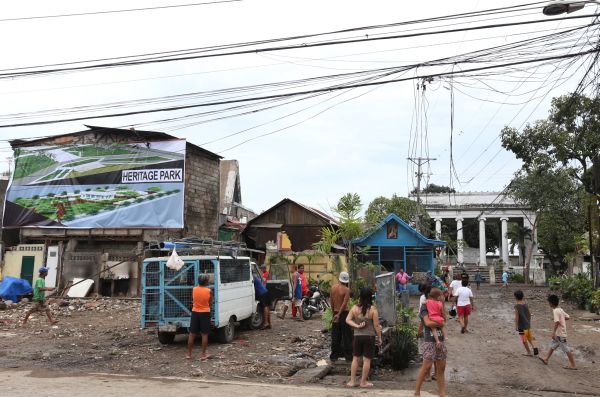
The area in front of the Dona Pepang mausoleum is cleared of illegally built houses. The clearing is part of the city government’s plan to convert the cemetery into a heritage park. (CDN PHOTO/JUNJIE MENDOZA)
The living are evicted and the dead — the remains — are exhumed from the Doña Pepang Cemetery as the Cebu City government implements the refurbishing of the cemetery into a public heritage park.
Esmelita Espelita, 49, mother of three and grandmother of three more, belongs to one of the six families whose houses were demolished last week.
Nine homes in the cemetery and a public market which once fronted the cemetery have already been demolished last August.
“They are slowly making us leave because it’s All Souls’ Day and they are starting the widening of the road in the cemetery,” said Espelita in Cebuano.
Collin Rosell, chief of the Cebu City’s Department for the Welfare of the Urban Poor, assured the 39 affected families in the cemetery face-lift of a relocation site.
He said they were working on a socialized housing building in Lorega which will house 68 victims of a 2014 fire and some of those families evicted during the demolition in the Doña Pepang cemetery.
Rosell said they aim to finish demolishing the 39 houses in the cemetery by December.
TOMBS EXTRACTED
The remains in some tombs have also been exhumed and transferred to a columbary by City Hall.
Editha Sentillas, 65, said she was at the Doña Pepang cemetery when one of her relatives told her that the remains of some of her dead family members — the Querubins — were extracted.
“Here I was, thinking that it’s All Souls’ Day and I came to visit the tomb of my mother just to be told that they have been treated this way?” Sentillas said in Cebuano.
Her family members were buried directly behind the Osmeñas. Now the tombs have been opened and the remains exhumed. Some bones in the adjacent tomb are even peeking out of the soil.
PART OF REHAB
One of the caretakers in Doña Pepang, who asked not to be named, said they were told to dig out all the old and abandoned tombs and graves, as this is the first step to the rehabilitation of the area.
“The bones of the dead have been exposed because the graves have been dug closely. So when we extracted the caskets, the bones and even the head of the dead would sometimes stick out in the tombs,” the caretaker said in Cebuano.
Rosell said that it was not their intention to expose any buried bones.
He said they were only trying to clear out the abandoned tombs, graves and mausoleums as a first step of their plan.
These are not necessarily empty but have not been cared for in recent years. The bones affected by the clearing will be moved to a bone chamber.
“Abandoned structures are what informal settlers use to form shelter in the cemetery. That’s why we have to clear them out, to prevent settlers from encroaching again into the cemetery, or else we’re back to square one — eviction,” he said.
Rosell said that the rehabilitation of this cemetery and converting it into a public heritage park is a five-year plan.
He said it was conceived by the previous administration and they are pursuing the project so as not to have any liabilities for not implementing it.
He added that they are only living up to the provisions they agreed with the Roman Catholic Archdiocese of Cebu (RCAC), which is to preserve the cemetery and its heritage.
The cemetery was once a property of the RCAC, and was exchanged for the city government’s land in barangay Pasil in a land-swap deal in 2011.
Several families have mausoleums in the Doña Pepang Cemetery, including the Doña Pepang mausoleum which contains the remains of Doña Pepang, the wife of the former president Sergio Osmeña Sr.
Other prominent families with mausoleums in the cemetery include the Escaños, Brioneses, and Jerezes.